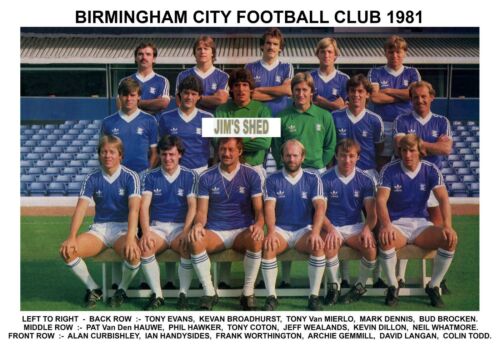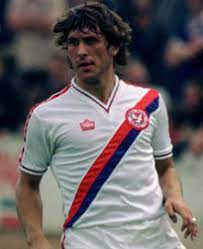12. Apr, 2022
CRYSTAL PALACE: WHATEVER HAPPENED TO THE TEAM OF THE 80s?
Who is the biggest club in England never to win a major trophy? I reckon a large share of the vote would go to Crystal Palace, Although fans of Bristol City ,Bristol Rovers, Watford, Hull City, Brighton & Hove Albion and Plymouth Argyle have good claims to the unwanted accolade .
I've plumped for Palace because of their longevity at the top table of English football. With the exception of Plymouth all the other clubs had mixed with the cream, Watford in particular have shown remarkable fortitude for a club with limited resources. But the Eagles of South London have had a prolonged relationship with Premier League football. Palace are currently enjoying their 8th consecutive season in England's top division.
Crystal Palace have finished 3rd in the top flight and have twice been FA Cup Runners Up. On both occasions (1990 and 2016) Palace were thwarted by Manchester United. Even more guiling Palace led in Extra Time in both games before United came back to win. In 2016 the Red Devils were reduced to 10 men but still overturned a deficit.
For the majority of their 116 years in existence Palace have operated in the backwaters, the Third Division or Third Division (South) appeared to be their natural environment. That changed in 1969 when manager Bert Head led Palace to the promised land of First Division football for the first time in their history. They fought gamely and had their moments in the big time. In December 1972 Head's team hammered Manchester United 5-0 at Shelhurst Park. Don Rodgers was the star turn, the exciting winger scoring 2 of the home sides goals. It wasn't the first time Rodgers had given a big boy a bloody nose. In 1969 he scored twice as Swindon Town famously humbled Arsenal in the League Cup Final. At the time Swindon were a Third Division club.
Palace were relegated in 1973 just after Malcolm Allison was appointed manager. Arguably Big Mal was the most important figure in the modern history of CPFC. His influence stretched way beyond the pitch. The traditional Claret and Blue colours were shelved. Crystal Palace now turned out in Red and Blues stripes, a kit based on Barcelona's famous shirt. Alison had done a similar thing at Manchester City, changing City's away shirt to the red and black stripes originally worn by AC Milan.
The makeover also encompassed a change of nickname. Palace were known as The Glaziers, a reference to the large exhibition building which gave the area its name. The massive glass construction was named the Crystal Palace. The club's badge was changed to an Eagle and Palace were now christened the Eagles.
All these gimmicks must have cut little ice on the Homesdale Road terrace particularly when Palace suffered a second successive relegation in 1974. The Eagles were hardly soaring indeed I doubt Allison would have kept his job these days. Yet a sparkling FA Cup run in 1976 raised spirits. Third Division Palace beat Leeds, Chelsea and Sunderland to reach the Semi Final. Winger Peter Taylor rose to prominence. He scored twice in the Fifth Round win at Stamford Bridge. Palace won 3-1 as Taylor set up the other goal for Nicky Chatterton. His majestic form even earned him 5 England caps. Taylor became the first Third Division player in 21 years to represent England at Senior level. Bristol City legend John Ayteo was the last in 1955.
Ever the showman, Big Mal was in his element. He started wearing a Fedora hat after donning it before the Third Round win at Scarborough, Allison had read that Portsmouth manager Jack Taylor had wore a Fedora before each round of the 1939 competition. Pompey went on to beat Wolves in the Final. But Allison's luck ran out in the Semi Final, Southampton beat Palace 2-0 at Stamford Bridge.
He was soon turfed out of Shelhurst Park. The cup run had papered over the cracks, Crystal Palace had failed to win promotion from Division Three. The board were also alarmed by Big Mal's antics, these included inviting model Fiona Richmond to enjoy a dip in the team bath. The Crystal Palace boss was famously pictured bathing with the Page 3 girl. A bit much in Seventies Croydon, heaven knows what his fate would be today.
Terry Venables, Allison's assistant, took over. Within 4 years the Eagles were back in the First Division. They were Second Division champions in 1979. All looked rosy in the Palace garden and Venables team were soon labelled the Team of The eighties. The Eagles had won the FA Youth Cup in 1976 and 1977. That side included promising youngsters Kenny Sansom, Billy Gilbert and Vince Hilare. All three had broken into the first team, complementing wise old heads Jim Cannon and Dave Swindlehurst.
The kit had changed again. The Team Of The Eighties now wore a white shirt with a blue and red slash (as modeled by Sansom in cover photo). Unlike the Allison era, the hype seemed justified in September 1979 they beat Ipswich Town 4-1 at Shelhurst Park. The win put them top of the First Division for the first time in their history. It should have been the start of a new football dynasty instead it triggered a downward spiral.
Palace were now viewed as genuine title challengers, the team which could unseat Liverpool. That theory was soon disproved, in October 1979 Liverpool beat Palace 3-0 at Anfield. The Merseyside drubbing knocked the stuffing out of Venables bright young things, form dipped alarmingly and the South Londoners finished 13th.
The rot had set in, Sansom joined Arsenal in the Summer of 1980, the full back was part of a swop deal which saw striker Clive Allen sign for Palace. Bizarrely Allen had been an Arsenal player for just 62 days before he was deemed surplus to requirements. The transfer failed to reverse fortunes although little blame could be laid at Clive Allen's door. The Eagles won just once in their first 10 league games.
Luck deserted them. In early September the Eagles visited Coventry City. The Sky Blues were 2-1 up, when Palace were awarded a free kick on the edge of the Coventry penalty area. Allen struck a beauty which flew past Jim Blyth and hit the stanchion of the net before rebounding back into play. Irate Eagles players asked the referee to consult the linesman. Their pleas fell on deaf ears, no goal was the verdict. Coventry compounded the misery by scoring a third late on. By chance the game was featured on Match Of The Day. Action replays confirmed the goal should have stood, a sheepish Jimmy Hill confirmed. At the time the MOTD presenter was also chairman of Coventry City.
Two months later Venables resigned to become manager of Queens Park Rangers, the inevitable relegation followed in the Spring of 1981. Many feel Terry Venables took his eye off the ball. In a Sky documentary Cannon and Swindlehurst suggest Venables devoted too much time to his off the field activities.
The Palace manager had several business interests in London. He also embarked on literary career. Venables was the co-author of the Hazzel detective books. The books described the adventures of James Hazzel, a street wise Cockney detective. The books proved popular, ITV produced a TV series based on them. Nicolas Ball taking the title role.
Clive Allen takes a different tack. In his autobiography he suggests that the young players had become too accustomed to success, they were therefore unable to deal with the first trace of adversity. He also hints at a dressing room divided between the clubs home grown talent and the players who had arrived from other clubs.
Conversely Palace's golden era arrived at the tail end of the 1980's. In 1983 Ron Noades brought the club, a year later he appointed Steve Coppell Eagles boss. The former Manchester United and England winger had recently retired from playing. At 29 he was the youngest manager in the Football League. Coppell signed striker Ian Wright from none league football. Wright went on to form a lethal strike partnership with Mark Bright. Midfielders Geoff Thomas and Andy Gray proved inspired signings, in later years they both played for England. In 1989 the Eagles were promoted to the First Division. In September of that year they were hammered 9-0 by Liverpool, the Eagles gained revenge 6 months later, beating the Reds 4-3 in a memorable FA Cup Semi Final. They lost a replayed final to Coppell's former club but survived comfortably in the top flight.
A year later they finished 3rd, in contrast the Team Of The Eighties had enjoyed little success. Kenny Sansom, was the exception. The full back won 86 caps for England and was regarded as the best left back in the World.
This Sunday Crystal Palace face Chelsea in a FA Cup Semi Final. Things are buzzing again down Croydon way. The appointment of Patrick Viera as Palace boss appears a masterstroke by chairman Steve Parish. Viera seems to have taken the transition from legendary player to successful manager in his stride. A step which appears beyond Steven Gerrard and Frank Lampard.

